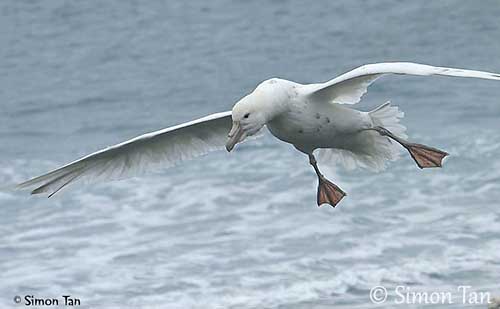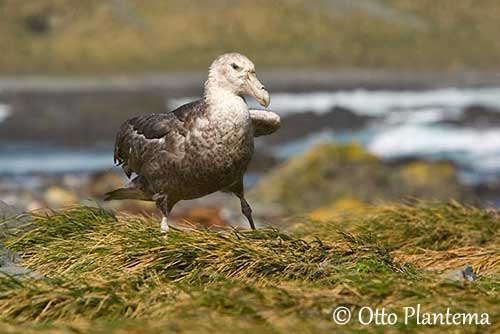
Fr: Pétrel géant
All: Riesensturmvogel
Esp: Abanto-marino Antártico
Ita: Ossifraga
Nd: Zuidelijke Reuzenstormvogel
Sd: Sydlig jättestormfågel
Photographers:
John Anderson
John Anderson Photo Galleries
Otto Plantema
Trips around the world
Simon Tan
PBase Bird galleries
Text by Nicole Bouglouan
Sources:
HANDBOOK OF THE BIRDS OF THE WORLD vol 1 by Josep del Hoyo-Andrew Elliot-Jordi Sargatal - Lynx Edicions - ISBN: 8487334105
BirdLife International (BirdLife International)
Department of Sustainability, Environment, Water, Population and Communities
New Zealand birds and birding (Narena Olliver)
Southern Giant Petrel
Macronectes giganteus
Procellariiformes Order – Procellariidae Family
INTRODUCTION:
The Southern Giant Petrel is very similar to the Northern Giant Petrel (M. halli), but the southern species has two distinct colour morphs, dark and white.
Until the 1960s, they were not identified as separate species, but more detailed study of their breeding biology indicated that they were two distinct species. They breed side by side on Macquarie Island.
DESCRIPTION OF THE BIRD:
Biometrics:
Length: 86-99 cm
Wingspan: 185-205 cm
Weight: M: 5 kg – F: 3,8 kg
DARK MORPH
The adult has grey-brown plumage with paler, faded, mottled white head, neck and breast.
The underparts are dark from lower breast to undertail-coverts. On the underwing, the bases of the outer flight feathers are silvery and the leading edge is pale near the body, unlike the Northern Giant Petrel in which this area is dark brown.

The large, strong bill is flesh-coloured with darker greyish to greenish-grey tip. It is surmounted by a large, single nostril-tube. The eyes can be dark brown, but more often pale grey. Legs and webbed feet are dark grey to dusky flesh-grey.
Both sexes are similar, in plumage, but the female is slightly smaller than the male.
The juvenile has dark brown plumage with dark brown eyes, fairly similar to the juvenile Northern Giant Petrel. It acquires progressively pale brown and white plumage.
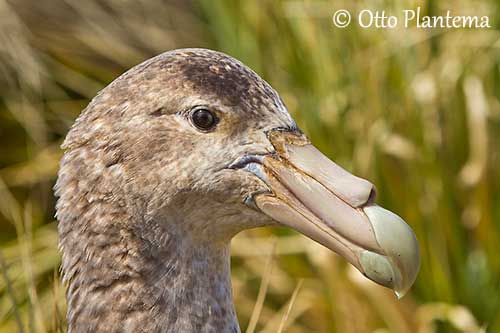
WHITE MORPH
About 15% of some local populations have white morph.
The plumage is white overall, except for a few scattered dark feathers. The eyes are dark brown.
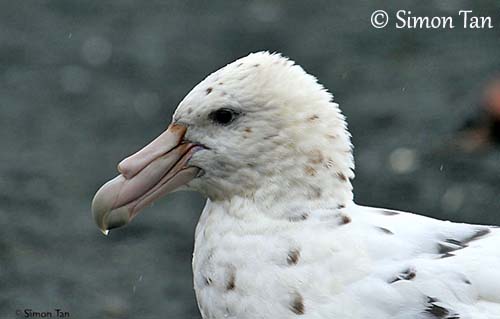
RANGE:
The Southern Giant Petrel has circumpolar distribution in Southern Ocean. It breeds in Antarctica and from S Chile and SC Argentina, E through the sub Antarctic islands to Heard I and Macquarie I.
HABITAT:
The Southern Giant Petrel is marine, and occurs from coastal to pelagic waters. It is present into areas of pack ice, and N into subtropical zones, as far North as Brazil in the South Atlantic.
It breeds on low flats, gentle slopes or ridge tops in open vegetation or grassy or bare ground, and also on headlands. It feeds often along the coasts.
CALLS AND SONGS: SOUNDS BY XENO-CANTO
The Southern Giant Petrel produces guttural growling and utters whinnying calls during displays, as well courtship as threat behaviour. When alarmed or threatened, it snaps its bill and “clacks” the bill while mating. The chicks give piping calls, soft “peep” sounds.
When they are feeding in group, the flock is very noisy.
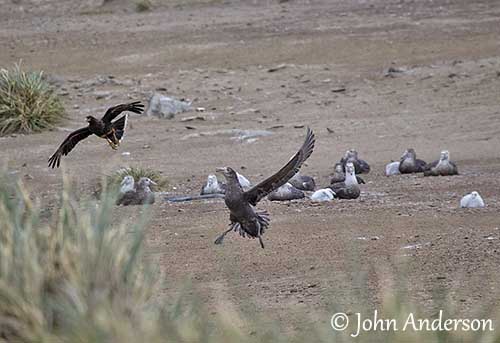
BEHAVIOUR IN THE WILD:
The Southern Giant Petrel is a scavenger, feeding on wide variety of carrion and carcasses of penguins, albatrosses and marine mammals, and also ship offal.
This large bird takes and kills the chicks of penguins and albatrosses. It also catches seabirds as large as an adult albatross.
Seabirds can be taken on the wing and battered to death against the sea surface before to be eaten. Adult albatrosses can be killed too by drowning. The petrel seizes a sleeping albatross by the neck and drowns it by forcing its head underwater.
It also takes fish and squid by surface-seizing, surface-diving and pursuit-plunging.
They are aggressive and opportunistic feeders.
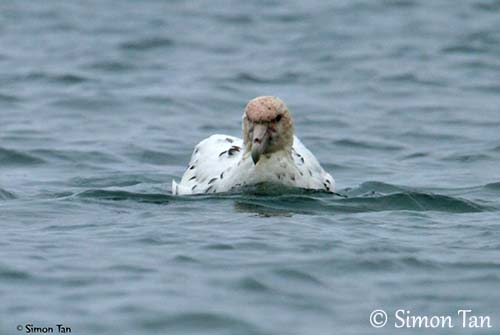
The Southern Giant Petrel has strong legs and feet allowing the bird to walk on the ground. Its huge bill is used for opening marine mammals’ carcasses. Once the hole is large enough, it inserts bill and head into the hole to reach the internal organs. It is usually coated in blood while feeding.
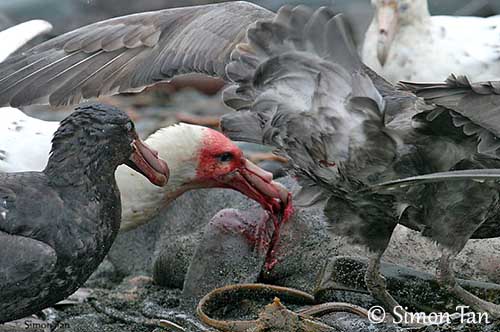
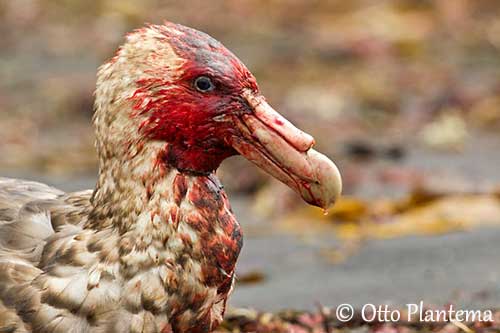
Around carcasses, the dominance is gained by threat displays, involving wings spread, tail raised and fanned, neck arched, and bill open pointing downwards.
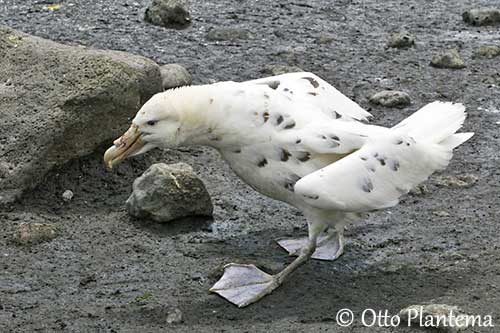
During the breeding season, the Southern Giant Petrel performs courtship displays involving head-raising, bill-fencing, bill-kissing and mutual preening. All these displays are accompanied by loud, whinnying calls.
It also performs aerial displays, but this behaviour is reported all year round. They are monogamous.
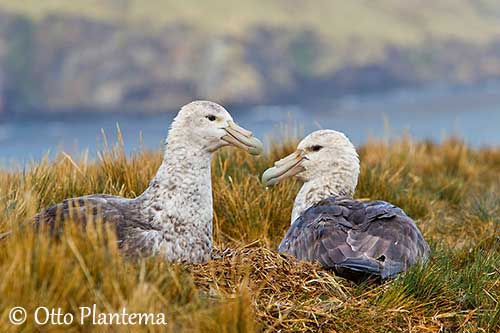
The non-breeding birds (up to 100 birds) roost together on the ground. They can be seen on beaches but also in water, usually with Northern Giant Petrel.
The adults only disperse to adjacent waters, whereas the juveniles move E around Southern Ocean by following the winds. However, immature birds move further N and can reach the tropics. They usually follow the cold water currents off South Africa and W South America.
The Southern Giant Petrel is a powerful flier and is able to perform sustained flight over long distances.
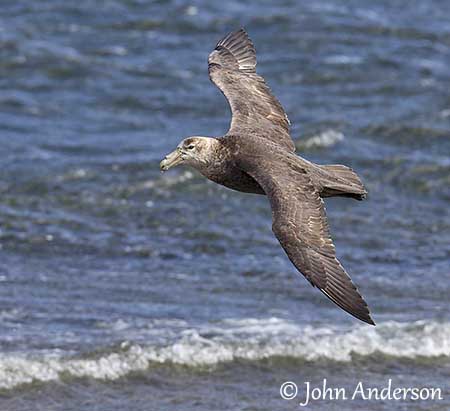
REPRODUCTION OF THIS SPECIES:
The breeding season starts in July, but it depends on the range.
The Southern Giant Petrel breeds in loose colonies of up to 300 pairs, established on open coastal plateaux and headlands or gentle slopes, in open vegetation but not in tussock like the Northern Giant Petrel.
The nest is built by both adults. This is a low large cup made with grass, moss, small stones and bones. But sometimes, it is only a scratch in grass, sand or rocks.
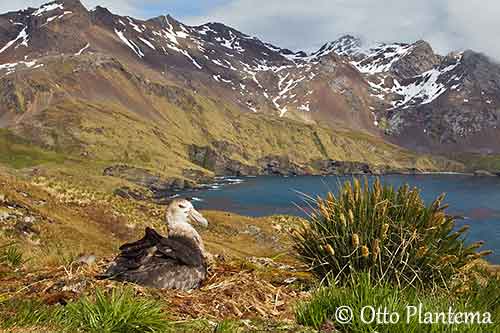
The female lays a single white egg between August and November. The incubation lasts about two months and is shared by both parents, with stints of 2-12 days. The white downy chick is brooded for 2-3 weeks, and mainly fed by the male. It fledges 100-130 days after hatching.
The chicks are harassed and preyed upon by skuas. Both adults and chicks defend themselves by bill-snapping, and squirting foul-smelling oil fluid through the mouth towards the predator.
PROTECTION / THREATS / STATUS:
The Southern Giant Petrel is still killed (caught and drowned) on illegal longline fisheries in Southern Ocean, and in trawl fisheries in the Falkland Islands. But thanks to better management of these techniques, this threat is now reduced around some breeding colonies.
Some declines are caused by reduction of carrion, human disturbances, persecution, ingestion of debris and oil pollution at sea.
The population size is estimated at 65,000/100,000 mature individuals, and the Southern Giant Petrel is not currently threatened.
